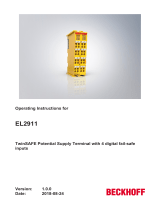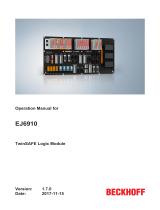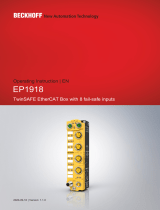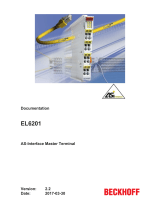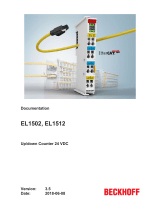Page is loading ...

Operating Instructions for
EK1960
TwinSAFE Compact Controller
1.3.1
2019-01-28
Version:
Date:


Table of contents
EK1960 3Version: 1.3.1
Table of contents
1 Foreword ....................................................................................................................................................7
1.1 Notes on the documentation..............................................................................................................7
1.2 Safety instructions .............................................................................................................................8
1.2.1 Delivery state ..................................................................................................................... 8
1.2.2 Operator's obligation to exercise diligence ........................................................................ 8
1.2.3 Description of safety symbols ............................................................................................ 9
1.3 Documentation issue status ............................................................................................................10
1.4 Version history of the TwinSAFE product........................................................................................11
2 System description TwinSAFE...............................................................................................................12
2.1 Extension of the Beckhoff I/O system with safety functions ............................................................12
2.2 Safety concept.................................................................................................................................12
3 Product description.................................................................................................................................13
3.1 General description .........................................................................................................................13
3.2 Product designations .......................................................................................................................14
3.3 Inputs and outputs of the EK1960 ...................................................................................................15
3.4 Connection technology ....................................................................................................................18
3.4.1 Power supply spring contact strip .................................................................................... 18
3.4.2 Input and output spring contact strip................................................................................ 18
3.4.3 Relay contact spring contact strip.................................................................................... 18
3.5 Intended use....................................................................................................................................19
3.6 Technical data .................................................................................................................................20
3.6.1 Technical data – relay option........................................................................................... 22
3.7 Safety parameters ...........................................................................................................................24
3.8 Error response times .......................................................................................................................26
3.9 Characteristic curve of the inputs ....................................................................................................27
3.10 Test pulses for the outputs ..............................................................................................................27
3.11 Load characteristic curve – inductive load.......................................................................................29
3.12 Block diagram of the EK1960 ..........................................................................................................30
3.13 Address setting of the TwinSAFE compact controller .....................................................................31
3.14 Dimensions......................................................................................................................................32
3.15 Wiring examples ..............................................................................................................................32
3.15.1 Inputs and outputs ........................................................................................................... 32
3.15.2 Clocked signals................................................................................................................ 36
4 Operation..................................................................................................................................................37
4.1 Environmental conditions ................................................................................................................37
4.2 Installation ......................................................................................................................................37
4.2.1 Safety instructions ........................................................................................................... 37
4.2.2 Transport / storage .......................................................................................................... 37
4.2.3 Mechanical installation..................................................................................................... 37
4.2.4 Electrical installation ........................................................................................................ 40
4.3 Configuration of the controller in TwinCAT......................................................................................42
4.3.1 Configuration requirements ............................................................................................. 42
4.3.2 Insertion of a controller .................................................................................................... 42

Table of contents
EK19604 Version: 1.3.1
4.3.3 Creating a safety project in TwinCAT3 ........................................................................... 43
4.3.4 Downloading the safety application ................................................................................. 75
4.4 Info data...........................................................................................................................................79
4.4.1 Info data for the connection ............................................................................................ 79
4.4.2 Info data for function blocks............................................................................................. 80
4.4.3 Info data for the TwinSAFE group ................................................................................... 81
4.4.4 Info data for the device .................................................................................................... 82
4.5 Version history.................................................................................................................................83
4.6 User Administration .........................................................................................................................84
4.7 Backup/Restore ...............................................................................................................................86
4.8 Export/import of the safety project...................................................................................................90
4.9 Diag History tab ...............................................................................................................................92
4.10 TwinSAFE SC configuration ............................................................................................................93
4.11 Customizing / disabling TwinSAFE groups......................................................................................97
4.12 Saving the analog group inputs persistently..................................................................................100
4.13 New features in TC3.1 Build 4022.................................................................................................101
4.13.1 Group status .................................................................................................................. 101
4.13.2 Online view group ports................................................................................................. 103
4.13.3 Group templates ............................................................................................................ 103
4.13.4 Networks collapsable..................................................................................................... 103
4.13.5 Subfolder Alias Devices................................................................................................. 104
4.13.6 Goto linked element....................................................................................................... 105
4.13.7 Path view to linked signal .............................................................................................. 105
4.13.8 Multiline comments........................................................................................................ 106
4.13.9 Names of Alias Devices in the process image............................................................... 107
4.13.10 Project settings - Verification ......................................................................................... 108
4.13.11 Displaying the project size............................................................................................. 108
4.13.12 Copy and Paste for FBs and comments........................................................................ 109
4.13.13 Global settings in Visual Studio ..................................................................................... 111
4.13.14 Sorting ........................................................................................................................... 113
4.13.15 Direct mapping of local I/Os........................................................................................... 115
4.13.16 Backup/Restore settings................................................................................................ 116
4.13.17 Multiple download.......................................................................................................... 117
4.14 Diagnostics ....................................................................................................................................120
4.14.1 Diagnostic LEDs ............................................................................................................ 120
4.14.2 Status LEDs................................................................................................................... 122
4.14.3 Diagnostic objects.......................................................................................................... 123
4.14.4 Cycle time of the safety project...................................................................................... 124
4.14.5 Diagnosis History........................................................................................................... 125
4.15 Project design limits of the EK1960...............................................................................................128
4.16 Behavior when restarting...............................................................................................................128
4.17 Sync-Manager Configuration.........................................................................................................129
4.18 Reaction times of local signals ......................................................................................................131
4.19 TwinSAFE reaction times ..............................................................................................................131
4.20 Reaction times Bumper mode .......................................................................................................133
4.21 Reaction times ambient conditions................................................................................................133

Table of contents
EK1960 5Version: 1.3.1
4.22 Maintenance ..................................................................................................................................133
4.22.1 Cleaning......................................................................................................................... 133
4.23 Service life .....................................................................................................................................134
4.23.1 Decommissioning .......................................................................................................... 135
4.24 Firmware update of TwinSAFE products.......................................................................................136
5 Appendix ................................................................................................................................................139
5.1 Support and Service ......................................................................................................................139
5.2 Certificates.....................................................................................................................................140

Table of contents
EK19606 Version: 1.3.1

Foreword
EK1960 7Version: 1.3.1
1 Foreword
1.1 Notes on the documentation
Intended audience
This description is only intended for the use of trained specialists in control and automation engineering who
are familiar with the applicable national standards.
It is essential that the following notes and explanations are followed when installing and commissioning
these components.
The responsible staff must ensure that the application or use of the products described satisfy all the
requirements for safety, including all the relevant laws, regulations, guidelines and standards.
Origin of the document
This documentation was originally written in German. All other languages are derived from the German
original.
Currentness
Please check whether you are using the current and valid version of this document. The current version can
be downloaded from the Beckhoff homepage at http://www.beckhoff.com/english/download/twinsafe.htm.
In case of doubt, please contact Technical Support [}139].
Product features
Only the product features specified in the current user documentation are valid. Further information given on
the product pages of the Beckhoff homepage, in emails or in other publications is not authoritative.
Disclaimer
The documentation has been prepared with care. The products described are subject to cyclical revision. For
that reason the documentation is not in every case checked for consistency with performance data,
standards or other characteristics. We reserve the right to revise and change the documentation at any time
and without prior announcement. No claims for the modification of products that have already been supplied
may be made on the basis of the data, diagrams and descriptions in this documentation.
Trademarks
Beckhoff
®
, TwinCAT
®
, EtherCAT
®
, EtherCATP
®
, SafetyoverEtherCAT
®
, TwinSAFE
®
, XFC
®
and XTS
®
are
registered trademarks of and licensed by Beckhoff Automation GmbH.
Other designations used in this publication may be trademarks whose use by third parties for their own
purposes could violate the rights of the owners.
Patent Pending
The EtherCAT Technology is covered, including but not limited to the following patent applications and
patents: EP1590927, EP1789857, DE102004044764, DE102007017835 with corresponding applications or
registrations in various other countries.
The TwinCAT Technology is covered, including but not limited to the following patent applications and
patents: EP0851348, US6167425 with corresponding applications or registrations in various other countries.

Foreword
EK19608 Version: 1.3.1
EtherCAT
®
and Safety over EtherCAT
®
are registered trademarks and patented technologies, licensed by
Beckhoff Automation GmbH, Germany.
Copyright
© Beckhoff Automation GmbH & Co. KG, Germany.
The reproduction, distribution and utilization of this document as well as the communication of its contents to
others without express authorization are prohibited.
Offenders will be held liable for the payment of damages. All rights reserved in the event of the grant of a
patent, utility model or design.
Delivery conditions
In addition, the general delivery conditions of the company Beckhoff Automation GmbH & Co. KG apply.
1.2 Safety instructions
1.2.1 Delivery state
All the components are supplied in particular hardware and software configurations appropriate for the
application. Modifications to hardware or software configurations other than those described in the
documentation are not permitted, and nullify the liability of Beckhoff Automation GmbH & Co. KG.
1.2.2 Operator's obligation to exercise diligence
The operator must ensure that
• the TwinSAFE products are only used as intended (see chapter Product description);
• the TwinSAFE products are only operated in sound condition and in working order.
• the TwinSAFE products are operated only by suitably qualified and authorized personnel.
• the personnel is instructed regularly about relevant occupational safety and environmental protection
aspects, and is familiar with the operating instructions and in particular the safety instructions contained
herein.
• the operating instructions are in good condition and complete, and always available for reference at the
location where the TwinSAFE products are used.
• none of the safety and warning notes attached to the TwinSAFE products are removed, and all notes
remain legible.

Foreword
EK1960 9Version: 1.3.1
1.2.3 Description of safety symbols
In these operating instructions the following instructions are used.
These instructions must be read carefully and followed without fail!
DANGER
Serious risk of injury!
Failure to follow this safety instruction directly endangers the life and health of persons.
WARNING
Risk of injury!
Failure to follow this safety instruction endangers the life and health of persons.
CAUTION
Personal injuries!
Failure to follow this safety instruction can lead to injuries to persons.
NOTE
Damage to the environment/equipment or data loss
Failure to follow this instruction can lead to environmental damage, equipment damage or data loss.
Tip or pointer
This symbol indicates information that contributes to better understanding.

Foreword
EK196010 Version: 1.3.1
1.3 Documentation issue status
Version Comment
1.3.1 • Layout corrected at chapter Sample program for parameterization
1.3.0 • Description of Module Fault Link active parameter added
• Description of Multiple Download added
• Description of input and output signals expanded
• Description of error response times added
• Version history of TwinSAFE product added
• Description of firmware update added
1.2.0 • Description of inductive load and free-wheeling diode changed
• New features TwinCAT 3.1 Build 4022 added
• Diagnosis history described
• Reaction times BumperMode and ambient conditions added
• Description TwinSAFE SC updated
• Description of Behavior when restarting added
• Project design limits adjusted
• Note to the permissible loads on the relay contacts added
1.1.0 • Note to the input and output process image added
• Description for Sync Manager configuration added
• TwinSAFE SC description updated
1.0.0 • Certificate added
• General document revision
• Description of input module 9 and 10 updated
0.7.0 • Load characteristics for inductive loads added
• Backup/Restore flow chart added
0.6.1 • User administration screenshots updated
• State and Diag of the TwinSAFE group updated
0.6.0 • Safety parameters adopted from review report
0.5.0 • Safety parameters revised
• Parameter values revised
• Diag messages added
0.4.0 • Safety concept requirements for the manual implemented
0.3.0 • Update of the designation of the contact points
• Addendum: illustration of the TwinSAFE compact controller without relay option
0.2.0 • Extension of the general description
• Description of diagnostic and status LEDs added
0.1.0 • Migration, layout adaptation

Foreword
EK1960 11Version: 1.3.1
1.4 Version history of the TwinSAFE product
This version history lists the releases of the software and hardware versions. A description of the respective
changes to the previous version is also listed.
Updated hardware and software
The TwinSAFE products are subject to a cyclical revision. We reserve the right to revise and
change the TwinSAFE products at any time and without notice.
These hardware and/or software changes do not give rise to any claims for changes to products
that have already been delivered.
A description of how a firmware update (software) can be carried out can be found in the chapter Firmware
update of TwinSAFE products [}136].
Date SW-Version HW-Version Changes
2017-05-02 01 00 • First Release
2017-07-14 02 01 • Optimized safety mat function
• Added support for backup/restore mode
• Protective circuit of the outputs changed
2018-09-19 03 01 • Local logic projects can now also be created without a linked
RUN signal.
• Time stamp for diagnostic messages corrected.
• FB Muting: After an FB error in the backwards operating mode,
the FB error can be acknowledged without restarting the
TwinSAFE group.
• An error acknowledgement is now required after a user has
logged in to the Logic without deleting the project.
• Support of Module Fault Link active parameter added.
• Firmware and vendor data CRCs can be read out in CoE objects.

System description TwinSAFE
EK196012 Version: 1.3.1
2 System description TwinSAFE
2.1 Extension of the Beckhoff I/O system with safety
functions
The TwinSAFE products from Beckhoff enable convenient expansion of the Beckhoff I/O system with safety
components, and integration of all the cabling for the safety circuit within the existing fieldbus cable. Safe
signals can be mixed with standard signals as required. The transfer of safety-related TwinSAFE telegrams
is handled by the standard controller. Maintenance is simplified significantly thanks to faster diagnosis and
simple replacement of components.
The following basic functionalities are included in the TwinSAFE components:
digital inputs (e.g. EL19xx, EP1908), digital outputs (e.g. EL29xx), drive components (e.g. AX5805) and logic
units (e.g. EL6900, EL6910). For a large number of applications, the complete safety sensor and actuator
technology can be wired on these components. The required logical link of the inputs and the outputs is
handled by the EL69xx. In addition to Boolean operations, the EL6910 now also enables analog operations.
2.2 Safety concept
TwinSAFE: Safety and I/O technology in one system
• Extension of the familiar Beckhoff I/O system with TwinSAFE components
• Safe and non-safe components can be combined as required
• Logical link of the I/Os in the EL69xx TwinSAFE logic terminal
• Suitable for applications up to SIL3 according to EN61508:2010 and Cat4, PLe according to
ENISO13849-1:2015
• Safety-relevant networking of machines via bus systems
• In the event of an error, all TwinSAFE components always switch to the wattless and therefore safe
state
• No safety requirements for the higher-level standard TwinCAT system
Safety over EtherCAT protocol (FSoE)
• Transfer of safety-relevant data via any media (“genuine black channel”)
• TwinSAFE communication via fieldbus systems such as EtherCAT, Lightbus, PROFIBUS, PROFINET
or Ethernet
• IEC 61508:2010 SIL 3 compliant
• FSoE is IEC standard (IEC 61784-3-12) and ETG standard (ETG.5100)
Fail-safe principle (fail stop)
The basic rule for a safety system such as TwinSAFE is that failure of a part, a system component or the
overall system must never lead to a dangerous condition. The safe state is always the switched off and
wattless state.
CAUTION
Safe state
For all TwinSAFE components the safe state is always the switched-off, wattless state.

Product description
EK1960 13Version: 1.3.1
3 Product description
3.1 General description
EK1960 – TwinSAFE-Compact-Controller
The EK1960 is a TwinSAFE controller with 20 fail-safe inputs and 24 fail-safe outputs. The EK1960-2600
and EK1960-2608 variants feature an additional four relays, each with one make contact.
The EK1960 TwinSAFE compact controller is suitable for safety applications up to SIL 3 according to
IEC62061 and IEC61508 and up to Cat. 4, PL e according to ENISO13849-1:2015. (See following list for
restrictions):
• The single-channel relay output is suitable up to Cat. 2, PL d
• The two-channel relay output (use of two relay contacts in series) is suitable up to Cat. 3, PL d or Cat.
4, PL e, depending on the number of actuations. Cat. 4, PL e requires an actuation at least once per
month, Cat. 3, PL d at least once per year.
• The safe input for the safety mat operation mode is limited to Cat. 2, PL d.
Special proof tests are not necessary during the entire lifetime of the EK1960 on account of the high level of
diagnostic coverage.
The EK1960 can be used in three different application cases:
• As a stand-alone TwinSAFE compact controller without the use of an EtherCAT network with 20 inputs
and 24 outputs. An extension with terminals to the right of the EK1960 on the E-bus is not possible in
this operation mode.
• As a TwinSAFE compact controller integrated into an EtherCAT network. The EK1960 can be
extended with standard and safety terminals on the E-bus connection and via the EtherCAT network.
• As a TwinSAFE I/O module. The logic on the TwinSAFE compact controller is not used. The coupler
can be addressed by a TwinSAFE logic terminal as an I/O module with 20 inputs and 24 outputs.
The inputs of the EK1960 can be used as digital 24 V inputs. They can be fed to the safe input either with
static 24 V
DC
or with a clock from one of the TwinSAFE outputs of the EK1960 or via an external clock source
via, for example, a switch contact. Inputs 17 to 20 can additionally be switched to a safety mat operation
mode (Bumper Mode On) . Only safety mats operating according to the resistance-change principle are
supported. The safety mats can also be cascaded in accordance with the manufacturer's specifications. The
inputs can be parameterized in groups of two.
The outputs can be parameterized in groups of four. It is possible to set the mark-to-space-ratio and the
activation as a clock source for the safe inputs.

Product description
EK196014 Version: 1.3.1
Fig.1: EK1960-260x TwinSAFE-Compact-Controller
The EK1960 without relay option has a dummy cap on X4.
Fig.2: EK1960-000x TwinSAFE compact controller without relay option
3.2 Product designations
Product designation Description
EK1960-0000 EK1960 with EtherCAT RJ45 connections – without relay option
EK1960-0008 EK1960 with EtherCAT M8 connections – without relay option
EK1960-2600 EK1960 with EtherCAT RJ45 connections – with four potential-free contacts
(NO)
EK1960-2608 EK1960 with EtherCAT M8 connections – with four potential-free contacts (NO)
ZS2003-0001 Spare part, power supply spring contact strip, 4-pole
Contact spacing 3.5 mm
ZS2003-0002 Spare part, input/output spring contact strip, 10-pole
Contact spacing 3.5 mm
ZS2003-0003 Spare part, relay contact spring contact strip, 10-pole
Contact spacing 5.0 mm (EK1960-260x only)

Product description
EK1960 15Version: 1.3.1
3.3 Inputs and outputs of the EK1960
NOTE
Fuses for the EK1960
Fuses must be provided for the power supplies of the EK1960 2 A each for U
S
and U
P
(X3) and 5 A each for
U
P1
to U
P6
(X5, X7, X9).
plug contact Name Description
EtherCAT (X1) EtherCAT 1 EtherCAT connection 1
(RJ45 or M8)
EtherCAT (X2) EtherCAT 2 EtherCAT connection 2
(RJ45 or M8)
Power (X3) 1 U
s
Control voltage 24 V
DC
(SELV/PELV)
Supply of power for internal logic and E-bus connection
2 0V GND
3 U
p
Peripheral voltage 24V
DC
(SELV/PELV)
Supply of power for relays and inputs in the safety mat operation mode
4 0V GND
Relais (X4)
(EK1960-260x only)
1 4.1 Input to Relay 1 make contact
(Channel7.FSOUT RelaisModule.Channel1.Output)
2 4.2 Input to Relay 2 make contact
(Channel7.FSOUT RelaisModule.Channel2.Output)
3 4.3 Input to Relay 3 make contact
(Channel7.FSOUT RelaisModule.Channel3.Output)
4 4.4 Input to Relay 4 make contact
(Channel7.FSOUT RelaisModule.Channel4.Output)
5 n.c. not used
6 n.c. not used
7 4.5 Output to Relay 1 make contact
(Channel7.FSOUT RelaisModule.Channel1.Output)
8 4.6 Output to Relay 2 make contact
(Channel7.FSOUT RelaisModule.Channel2.Output)
9 4.7 Output to Relay 3 make contact
(Channel7.FSOUT RelaisModule.Channel3.Output)
10 4.8 Output to Relay 4 make contact
(Channel7.FSOUT RelaisModule.Channel4.Output)
Output (X5) 1 5.1 Output 1 from U
P1
(Channel1.FSOUT Module 1.Channel1.Output)
2 5.2 Output 2 from U
P1
(Channel1.FSOUT Module 1.Channel2.Output)
3 5.3 Output 3 from U
P1
(Channel1.FSOUT Module 1.Channel3.Output)
4 5.4 Output 4 from U
P1
(Channel1.FSOUT Module 1.Channel4.Output)
5 U
P1
Peripheral voltage U
P1
24 V
DC
(SELV/PELV)
6 5.5 Output 5 from U
P2
(Channel2.FSOUT Module 2.Channel1.Output)
7 5.6 Output 6 from U
P2
(Channel2.FSOUT Module 2.Channel2.Output)
8 5.7 Output 7 from U
P2
(Channel2.FSOUT Module 2.Channel3.Output)
9 5.8 Output 8 from U
P2
(Channel2.FSOUT Module 2.Channel4.Output)
10 U
P2
Peripheral voltage U
P2
24V
DC
(SELV/PELV)

Product description
EK196016 Version: 1.3.1
plug contact Name Description
Input (X6) 1 6.1 Input 1
(Channel8.FSIN Module 1.Channel1.Input)
2 6.2 Input 2
(Channel8.FSIN Module 1.Channel2.Input)
3 6.3 Input 3
(Channel9.FSIN Module 2.Channel1.Input)
4 6.4 Input 4
(Channel9.FSIN Module 2.Channel2.Input)
5 6.5 Input 5
(Channel10.FSIN Module 3.Channel1.Input)
6 6.6 Input 6
(Channel10.FSIN Module 3.Channel2.Input)
7 6.7 Input 7
(Channel11.FSIN Module 4.Channel1.Input)
8 6.8 Input 8
(Channel11.FSIN Module 4.Channel2.Input)
9 6.9 Input 9
(Channel12.FSIN Module 5.Channel1.Input)
10 6.10 Input 10
(Channel12.FSIN Module 5.Channel2.Input)
Output (X7) 1 7.1 Output 9 from U
P3
(Channel3.FSOUT Module 3.Channel1.Output)
2 7.2 Output 10 from U
P3
(Channel3.FSOUT Module 3.Channel2.Output)
3 7.3 Output 11 from U
P3
(Channel3.FSOUT Module 3.Channel3.Output)
4 7.4 Output 12 from U
P3
(Channel3.FSOUT Module 3.Channel4.Output)
5 U
P3
Peripheral voltage U
P3
24V
DC
(SELV/PELV)
6 7.5 Output 13 from U
P4
(Channel4.FSOUT Module 4.Channel1.Output)
7 7.6 Output 14 from U
P4
(Channel4.FSOUT Module 4.Channel2.Output)
8 7.7 Output 15 from U
P4
(Channel4.FSOUT Module 4.Channel3.Output)
9 7.8 Output 16 from U
P4
(Channel4.FSOUT Module 4.Channel4.Output)
10 U
P4
Peripheral voltage U
P4
24V
DC
(SELV/PELV)
Input (X8) 1 8.1 Input 11
(Channel13.FSIN Module 6.Channel1.Input)
2 8.2 Input 12
(Channel13.FSIN Module 6.Channel2.Input)
3 8.3 Input 13
(Channel14.FSIN Module 7.Channel1.Input)
4 8.4 Input 14
(Channel14.FSIN Module 7.Channel2.Input)
5 8.5 Input 15
(Channel15.FSIN Module 8.Channel1.Input)
6 8.6 Input 16
(Channel15.FSIN Module 8.Channel2.Input)
7 8.7 Input 17
(digital - Digital Mode On,
safety mat operation mode (resistance change) - Bumper Mode On)
(Channel16.FSIN Module 9.Channel1.Input)
8 8.8 Input 18
(digital - Digital Mode On,
safety mat operation mode (resistance change) - Bumper Mode On)
(Channel16.FSIN Module 9.Channel2.Input)
9 8.9 Input 19
(digital - Digital Mode On,
safety mat operation mode (resistance change) - Bumper Mode On)
(Channel17.FSIN Module 10.Channel1.Input)
10 8.10 Input 20
(digital - Digital Mode On,
safety mat operation mode (resistance change) - Bumper Mode On)
(Channel17.FSIN Module 10.Channel2.Input)

Product description
EK1960 17Version: 1.3.1
plug contact Name Description
Output (X9) 1 9.1 Output 17 from U
P5
(Channel5.FSOUT Module 5.Channel1.Output)
2 9.2 Output 18 from U
P5
(Channel5.FSOUT Module 5.Channel2.Output)
3 9.3 Output 19 from U
P5
(Channel5.FSOUT Module 5.Channel3.Output)
4 9.4 Output 20 from U
P5
(Channel5.FSOUT Module 5.Channel4.Output)
5 U
P5
Peripheral voltage U
P5
24V
DC
(SELV/PELV)
6 9.5 Output 21 from U
P6
(Channel6.FSOUT Module 6.Channel1.Output)
7 9.6 Output 22 from U
P6
(Channel6.FSOUT Module 6.Channel2.Output)
8 9.7 Output 23 from U
P6
(Channel6.FSOUT Module 6.Channel3.Output)
9 9.8 Output 24 from U
P6
(Channel6.FSOUT Module 6.Channel4.Output)
10 U
P6
Peripheral voltage U
P6
24V
DC
(SELV/PELV)
NOTE
Protected wiring
If the wiring of the outputs or the connected actuators leaves the control cabinet, the user must ensure that
the wiring is protected.
WARNING
Active loads
The use of active loads (with their own power supply) is not permissible unless the manufacturer of the load
ensures the non-reactivity of the power supply to the control signal.
DANGER
Clocked signals within a sheathed cable
Are clocked signals of different output modules used within a sheathed cable, a failure of a module, such as
cross-circuit or external power supply must lead to a switch off of all these modules. This switch off must be
performed by the user program.
From firmware version 03 and revision -0021 the parameter Module Fault Link active is available. If the pa-
rameter is set to TRUE for all modules involved, all these modules are set to the error state in the event of a
module error. This parameter is set to TRUE by default.

Product description
EK196018 Version: 1.3.1
3.4 Connection technology
3.4.1 Power supply spring contact strip
The power supply spring contact strip is required for the X3 connection.
Item number ZS2003-0001
Number of contacts 4
Contact spacing 3.5 mm
Connection methods Spring-loaded terminal technology
Wire cross-section (solid-wire) 0.2 – 1.5 mm²
Wire cross-section (fine-wire) 0.2 – 1.5 mm²
Conductor cross-sectional area – fine wire (with wire-
end ferrules with plastic collars)
0.25 – 0.75 mm²
Conductor cross-sectional area – fine wire (with wire-
end ferrules without plastic collars)
0.25 – 1.5 mm²
Strip length 8 - 9 mm
3.4.2 Input and output spring contact strip
The input and output spring contact strip is required for the connection X5 to X9.
Item number ZS2003-0002
Number of contacts 10
Contact spacing 3.5 mm
Connection methods Spring-loaded terminal technology
Wire cross-section (solid-wire) 0.2 – 1.5 mm²
Wire cross-section (fine-wire) 0.2 – 1.5 mm²
Conductor cross-sectional area – fine wire (with wire-
end ferrules with plastic collars)
0.25 – 0.75 mm²
Conductor cross-sectional area – fine wire (with wire-
end ferrules without plastic collars)
0.25 – 1.5 mm²
Strip length 8 - 9 mm
3.4.3 Relay contact spring contact strip
The relay contact spring contact strip is required for the connection X4 (EK1960-260x only).
Item number ZS2003-0003
Number of contacts 10
Contact spacing 5.0 mm
Connection methods Spring-loaded terminal technology
Wire cross-section (solid-wire) 0.2 – 2.5 mm²
Wire cross-section (fine-wire) 0.2 – 2.5 mm²
Conductor cross-sectional area – fine wire (with wire-
end ferrules with plastic collars)
0.25 – 1.5 mm²
Conductor cross-sectional area – fine wire (with wire-
end ferrules without plastic collars)
0.25 – 2.5 mm²
Strip length 9 - 10 mm

Product description
EK1960 19Version: 1.3.1
3.5 Intended use
WARNING
Caution - Risk of injury!
The TwinSAFE compact controller may only be used for the purposes described below!
The TwinSAFE compact controller expands the application range of the Beckhoff EtherCAT system by
functions that enable it to be used in the field of machine safety as well. The TwinSAFE compact controller is
designed for machine safety functions and the directly associated industrial automation tasks. It is therefore
approved only for applications with a defined fail-safe state. This safe state is the wattless state.
The EK1960 TwinSAFE compact controller is suitable for operation as
• Stand-alone Safety Controller
• a safety controller within an EtherCAT network
• a safety I/O device within an EtherCAT network with, for example, an EL6910 as TwinSAFE Master
WARNING
System limits
The TÜV-Süd certificate applies to the EK1960, the function blocks available in it, the documentation and
the engineering tool. Approved engineering tools are TwinCAT 3.1, TwinSAFE Loader and CODESYS
Safety for EtherCAT Safety Module. Any deviations from the procedures or tools, particularly externally
generated xml files for TwinSAFE import or externally generated automatic project creation procedures, are
not covered by the certificate.
WARNING
Power supply
The TwinSAFE compact controller must be supplied with 24 V
DC
by an SELV/PELV power supply unit with
an output voltage limit U
max
of 36 V
DC
. Failure to observe this can result in a loss of security.
WARNING
Commissioning test
Before the EK1960 can be used for the safety task, the user must carry out a commissioning test so that
sensor and actuator wiring errors can be ruled out.
CAUTION
Note the Machinery Directive
The TwinSAFE compact controller may only be used in machines within the meaning of the Machinery Di-
rective.
CAUTION
Ensure traceability
The buyer has to ensure the traceability of the device via the serial number.

Product description
EK196020 Version: 1.3.1
3.6 Technical data
Product designation EK1960
Number of inputs 20
Number of outputs 24 (+ 4 optional relay outputs)
Cable length between sensor and input 30 m (if cables with a cross-sectional area of 0.75mm²
are used)
Cable length between output and actuator 30 m (if cables with a cross-sectional area of 0.75mm²
are used)
Minimum/maximum logic cycle time approx. 1 ms / according the project size
Fault response time ≤ watchdog times
Watchdog time min. 2ms, max. 60,000ms
Input process image Dynamic, according to the TwinSAFE configuration in
TwinCAT3
Output process image Dynamic, according to the TwinSAFE configuration in
TwinCAT3
Supply voltage (SELV/PELV) 24V
DC
(–15%/+20%)
Provide a 2 A fuse for U
S
and U
P
E-bus power supply (5 V) max. 500mA
(In the case of higher current consumption,
please use the EL9410 power feed terminals in addition!)
Signal voltage inputs
see Characteristic curve of the inputs [}27]
Output module (4 channels) 24V
DC
(–15% / +20%) SELV/PELV for U
P1
to U
P6
max. 2A per channel
min. 30 mA with a test pulse length of 400 µs and
resistive load
Simultaneity factor 50% per module
Provide 5 A fuse for each U
Px
Diagnostic thresholds:
>4V -> high signal is detected
<2.4V -> low signal is detected
Permissible actuators
• inductive loads (see also Load characteristic curve –
inductive load [}29])
(A free-wheeling diode must be provided on the load)
• resistive loads
• capacitive loads
Current consumption of the modular electronics
at 24V
DC
(without current consumption of
sensors/actuators)
U
S
typ. 80 mA
U
P
typ. 2 mA
U
P1
to U
P6
each typ. 2mA
Dimensions (W x H x D) 230.5mmx 100mmx 58.6mm
Weight approx.560g (EK1960-260x)/
approx.500g(EK1960-000x)
Permissible ambient temperature (operation) -25 °C to +55 °C
Permissible ambient temperature (transport/
storage)
-40 °C to +70 °C
Permissible humidity 5% to 95%, non-condensing
permissible air pressure
(operation/storage/transport)
750hPa to 1100hPa
(this corresponds to an altitude of approx. -690m to
2450m above sea level, assuming an international
standard atmosphere)
/


